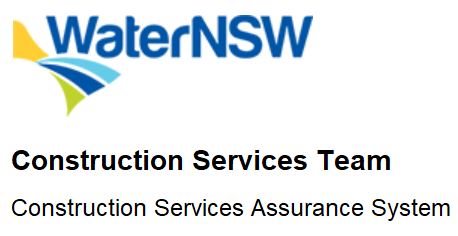Title Page
Project Details
-
Project Name:
-
Name of Principal Contractor:
Details of Work activity:
-
Brief description of work activity:
-
Location of work activity:
-
Map reference
-
Name of business / PCBU performing this work activity:
Details of SWMS compliance review:
-
Conducted on:
-
Reviewed by:
Review
SWMS document
-
Is the SWMS available at the work location?
-
Title of SWMS available on the job:
-
SWMS document number:
-
Revision number and date of SWMS:
-
The work should be stopped until a copy of the current SWMS is available at the work location
Construction Work Code of Practice 2014 - Safe Work Australia
4.3 Implementing a safe work method statement
The SWMS should be kept at the workplace where the high risk construction work will be carried out. If this is not possible, then a SWMS should be kept at a location where it can be delivered to the workplace quickly. A SWMS can also be kept electronically. -
Has the supervisor signed on to the SWMS?
-
Have all members of the work group signed on to the SWMS?
Work status and implementation of controls
-
Discuss with the work group - what part of the work activity are they currently performing?
-
Does the work in progress match the job step description in the SWMS?
-
If the work has been changed, has the SWMS been amended accordingly?
-
Check box to view definition of high risk construction work
-
Work Health and Safety Regulation 2017 [NSW] Chapter 6 Part 6.1
291 Meaning of “high risk construction work”
"high risk construction work" means construction work that:
(a) involves a risk of a person falling more than 2 metres, or
(b) is carried out on a telecommunication tower, or
(c) involves demolition of an element of a structure that is load-bearing or otherwise related to the physical integrity of the structure, or
(d) involves, or is likely to involve, the disturbance of asbestos, or
(e) involves structural alterations or repairs that require temporary support to prevent collapse, or
(f) is carried out in or near a confined space, or
(g) is carried out in or near:
(i) a shaft or trench with an excavated depth greater than 1.5 metres, or
(ii) a tunnel, or
(h) involves the use of explosives, or
(i) is carried out on or near pressurised gas distribution mains or piping, or
(j) is carried out on or near chemical, fuel or refrigerant lines, or
(k) is carried out on or near energised electrical installations or services, or
(l) is carried out in an area that may have a contaminated or flammable atmosphere, or
(m) involves tilt-up or precast concrete, or
(n) is carried out on, in or adjacent to a road, railway, shipping lane or other traffic corridor that is in use by traffic other than pedestrians, or
(o) is carried out in an area at a workplace in which there is any movement of powered mobile plant, or
(p) is carried out in an area in which there are artificial extremes of temperature, or
(q) is carried out in or near water or other liquid that involves a risk of drowning, or
(r) involves diving work. -
Have all relevant types of high risk construction work for this work activity been described in the SWMS?
-
The high risk construction work must be stopped and not resumed until there is a SWMS for the high risk construction work
-
Work Health and Safety Regulation 2017 [NSW] Chapter 6 Part 6.3 Division 2
299 Safe work method statement required for high risk construction work
(1) A person conducting a business or undertaking that includes the carrying out of high risk construction work must, before high risk construction work commences, ensure that a safe work method statement for the proposed work:
(a) is prepared, or
(b) has already been prepared by another person.
(2) A safe work method statement must:
(a) identify the work that is high risk construction work, and
(b) specify hazards relating to the high risk construction work and risks to health and safety associated with those hazards, and
(c) describe the measures to be implemented to control the risks, and
(d) describe how the control measures are to be implemented, monitored and reviewed. -
Discuss with the work group - what risk controls do they understand should be in place for this activity?
-
Does the work group understanding of the required controls match what is written in the SWMS?
-
For each of the risk controls described in the SWMS for this activity, look for evidence that it has been implemented
Risk control
-
Description of required control:
-
Is this risk control implemented?
-
Describe the observed evidence of this risk control
-
Do you consider that the work is being done in accordance with the SWMS?
-
The work must be stopped and not resumed until it is in accordance with the SWMS
-
Work Health and Safety Regulation 2017 [NSW] Chapter 6 Part 6.3 Division 2
300 Compliance with safe work method statement
(1) A person conducting a business or undertaking that includes the carrying out of high risk construction work must put in place arrangements for ensuring that high risk construction work is carried out in accordance with the safe work method statement for the work.
(2) If high risk construction work is not carried out in accordance with the safe work method statement for the work, the person must ensure that the work:
(a) is stopped immediately or as soon as it is safe to do so, and
(b) is resumed only in accordance with the statement.
Effectiveness of controls
-
Having observed the work in progress and the risk controls in place, do you consider that the chosen risk controls provide effective control of the hazards?
-
How do you consider that the controls could be improved?
Improvement suggestion
-
Description of potential improvement:
-
Discuss this suggestion with the supervisor - what is the outcome of the discussion?
-
The SWMS must be amended to include the agreed changes to the risk controls.
The new or revised controls must be implemented and the work group informed of the amended requirements -
What changes must be implemented immediately
Recommendation
Assessment:
-
I have reviewed on-site compliance with this Safe Work Method Statement and consider that:
- The work is being done in accordance with the SWMS; and the control measures implemented are effective
- The work is being done in accordance with the SWMS: and the control measures implemented required some change as described in this report
- The work is not being done in accordance with the SWMS; I have directed that the work must stop and not resume until it is in accordance with the SWMS









